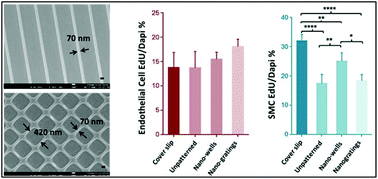Sub-100 nm patterning of TiO2 film for the regulation of endothelial and smooth muscle cell functions†
Abstract
Previous studies have shown that fundamental cell functions such as adhesion, proliferation, and morphology are regulated by the interaction of cells with basement membrane nano- and micron- scale surface topography. By taking the basement membrane as a guiding principle, the surface can be designed with biophysical cues in the form of surface topographies to modulate the cellular functions of vascular endothelial and smooth muscle cells, which are crucial for vascular diseases. Titanium-based materials whose surfaces are covered by a thin layer of titanium dioxide (TiO2) are utilized in several regenerative medicine applications such as vascular prosthetics. The utilization of TiO2-covered materials makes it essential to understand the interaction of cells with the TiO2 layer to control the cell response. While it has been shown by means of patterned micro- and nano-topography that it is important to regulate cell functions on non-metallic materials, it would be of interest in the field of regenerative medicine to study the cell response on patterned TiO2 surface layers. Previous studies have mostly focused on studying the cell response on random micro- and nano-roughened metallic and metal oxide surfaces as it is challenging to fabricate patterned TiO2 surface layers. Here, the biocompatibility of a method that is capable of the rational patterning of a continuous TiO2 surface layer of sub-100 nm resolution scale using thermally curable resin-based nanoimprinting was studied. The responses of human umbilical vein endothelial cell (HUVEC), such as proliferation, morphology and focal adhesions, and smooth muscle cell (SMC) proliferation and morphology to the nano-patterned TiO2 layer were investigated. Overall, the TiO2 layer with surface nano-gratings showed enhanced proliferation of HUVECs, while it significantly lowered the proliferation of SMCs as compared to the unpatterned control. The HUVECs and SMCs were shown by topography to be sensitive to the 70 nm gratings as evident by the regulation of proliferation and cell shape. A significantly lower focal adhesion density was found of HUVECs on TiO2 nano-gratings, while a significantly higher average focal adhesion size of HUVECs was seen on TiO2 nano-wells and nano-gratings, compared to the unpatterned controls.

- This article is part of the themed collection: In celebration of Michael Sefton’s 65th birthday

 Please wait while we load your content...
Please wait while we load your content...